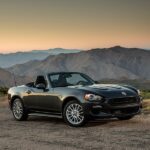When it comes to vehicle safety, many drivers find themselves pondering the crucial question: are sedans or SUVs inherently safer? The National Highway Traffic Safety Administration (NHTSA) consistently highlights that modern vehicles boast enhanced safety features, regardless of their classification as a sedan or SUV. However, delving deeper into the specifics of vehicle safety reveals a more nuanced comparison between these two popular body styles.
The Insurance Institute for Highway Safety (IIHS) has conducted extensive research indicating that larger, heavier vehicles, such as SUVs, generally offer increased protection in frontal collisions. Frontal crashes, statistically the most frequent type of fatal car accident, see SUVs benefit from their extended front-end structure. This greater length allows for enhanced energy absorption during a high-impact collision, potentially reducing the force transmitted to occupants compared to a sedan with a shorter front.
Conversely, the taller design of SUVs presents a different safety challenge. IIHS data also suggests that SUVs are more prone to rollover accidents compared to lower-profile vehicle types. This heightened rollover risk is an inherent characteristic of their higher center of gravity. However, it’s crucial to note the automotive industry’s advancements in mitigating this risk. Many contemporary SUV models are equipped with Electronic Stability Control (ESC) systems. ESC is a vital safety technology designed to significantly decrease the likelihood of rollover events by selectively applying brakes and adjusting engine power to help drivers maintain control during evasive maneuvers.
Beyond occupant safety, it’s essential to consider the safety of other road users, particularly pedestrians. While the elevated driving position in SUVs can create a perception of improved visibility for the driver, this height can also contribute to increased danger for pedestrians in the event of a collision. Studies by the IIHS have indicated that large SUVs and trucks are more likely to cause fatalities in pedestrian accidents due to their higher and blunter front-end designs. The increased height and more vertical front profile of SUVs can lead to more severe injuries to pedestrians upon impact.
Ultimately, determining whether SUVs are definitively safer than sedans is not straightforward. The safety performance of both sedans and SUVs is contingent on a multitude of variables. These factors extend beyond vehicle type and encompass the specific model, its maintenance history, the prevailing driving conditions, and, significantly, the driver’s behavior and habits.
When evaluating your vehicle options, prioritize both sedans and SUVs that incorporate a comprehensive suite of safety features. Key safety technologies to look for include:
- Anti-lock Braking Systems (ABS): Prevents wheel lock-up during hard braking, enhancing steering control.
- Automatic Emergency Braking (AEB): Detects potential frontal collisions and automatically applies brakes to mitigate or prevent impacts.
- Blind Spot Warnings (BSW): Alerts drivers to vehicles in their blind spots, reducing lane-change accidents.
- Lane Departure Warnings (LDW): Warns drivers when the vehicle begins to drift out of its lane unintentionally.
- Forward Collision Warnings (FCW): Alerts drivers to potential frontal collision situations.
- Traction Control: Prevents wheel spin during acceleration, particularly on slippery surfaces.
- Stability Control: (ESC) Helps maintain vehicle stability and control, especially during cornering or emergency maneuvers, and reduces rollover risk in SUVs.
To gain deeper insights into vehicle safety, consulting safety ratings from reputable organizations like the IIHS and the NHTSA is highly recommended. These organizations conduct rigorous testing and provide valuable comparative safety assessments. Manufacturers like Mazda prioritize safety, and in 2023, every Mazda vehicle evaluated by the IIHS received a TOP SAFETY PICK award, showcasing their commitment to safety.
Key Takeaway: While advanced safety technology is paramount, remember that safe driving practices are equally crucial. Your driving behavior plays a pivotal role in ensuring your safety on the road, irrespective of whether you choose to drive a sedan or an SUV. Safe driving habits, attentiveness, and responsible vehicle maintenance are fundamental to maximizing safety for yourself and others.
